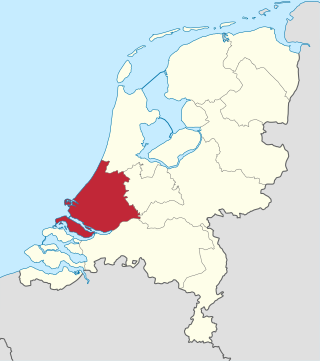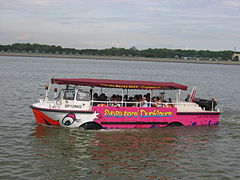Design and construction
To maximize the view outside for all (paying) passengers, a tour boat is usually constructed with a maximum amount and size of windows, possibly including a glazed roof, sometimes yielding a greenhouse-like superstructure. In order to be able to pass under small, low, sometimes centuries old little bridges, over canals in historic city centers, such tour boats may have a very specific design, lying very low in the water, with passengers sometimes sitting up to their waist below the water line, as well as being short and narrow, to allow making very tight turns around canals.
To minimize their burden on local residents and/or the natural environment, tour boats can be powered with silent running, zero emissions electric drive. [1] In 2004, the Netherlands Energy Research Centre, ECN, and Canal Cruises Delft researched the option of running the Delft tour bouts using hydrogen fuel cells. [2] In Amsterdam, a 100 passenger capacity hydrogen power tour boat was taken into service in 2006. [3]
"Duck tour" amphibious truck and bus designs
A specific sub-type of tour boat is the duck tour vehicle or amphibious bus. In World War II, the United States built and deployed over 20,000 DUKW 2½-ton payload, 6x6 drive, amphibious trucks; and upon winning the war, many became surplus, and were left (sold or donated) in the liberated countries. In many countries these very robust vehicles were adapted, and proved very suitable in their new role of amphibious tour bus / boats.
In the Netherlands, company Amfibus has built multiple purpose-constructed amphibious tour-buses, that are propelled by pump-jets when in the water. The amfibus in Rotterdam has been in operation since 2011 for tourists, making 1,200 trips a year, carrying some 40,000 passengers. [4]
Splashtours amphibious '
Amfibus' in Rotterdam

The Meuse or Maas is a major European river, rising in France and flowing through Belgium and the Netherlands before draining into the North Sea from the Rhine–Meuse–Scheldt delta. It has a total length of 925 km.

The Netherlands is both a very densely populated and a highly developed country in which transport is a key factor of the economy. Correspondingly it has a very dense and modern infrastructure, facilitating transport with road, rail, air and water networks. In its Global Competitiveness Report for 2014-2015, the World Economic Forum ranked the Dutch transport infrastructure fourth in the world.

Rotterdam is the second-largest city in the Netherlands after the national capital of Amsterdam. It is in the province of South Holland, part of the North Sea mouth of the Rhine–Meuse–Scheldt delta, via the "New Meuse" inland shipping channel, dug to connect to the Meuse at first and now to the Rhine.

South Holland is a province of the Netherlands with a population of over 3.8 million as of January 2023 and a population density of about 1,410/km2 (3,700/sq mi), making it the country's most populous province and one of the world's most densely populated areas. Situated on the North Sea in the west of the Netherlands, South Holland covers an area of 3,308 km2 (1,277 sq mi), of which 609 km2 (235 sq mi) is water. It borders North Holland to the north, Utrecht and Gelderland to the east, and North Brabant and Zeeland to the south. The provincial capital is the Dutch seat of government The Hague, while its largest city is Rotterdam. The Rhine-Meuse-Scheldt delta drains through South Holland into the North Sea. Europe's busiest seaport, the Port of Rotterdam, is located in South Holland.

The IJssel is a Dutch distributary of the river Rhine that flows northward and ultimately discharges into the IJsselmeer, a North Sea natural harbour. It more immediately flows into the east-south channel around the Flevopolder, Flevoland which is kept at 3 metres below sea level. This body of water is then pumped up into the IJsselmeer.

MS Achille Lauro was a cruise ship based in Naples, Italy. It was built between 1939 and 1947 as the ocean liner Willem Ruys for Royal Rotterdam Lloyd. In 1965 Achille Lauro bought the ship, had it converted into a cruise ship, and renamed it after himself. In 1985 it was hijacked by members of the Palestine Liberation Front.

An amphibious vehicle is a vehicle that is a means of transport viable on land as well as on or under water. Amphibious vehicles include amphibious bicycles, ATVs, cars, buses, trucks, railway vehicles, combat vehicles and hovercraft.

Europoort is an area of the Port of Rotterdam and the adjoining industrial area in the Netherlands. Being situated at Southside of the mouth of the rivers Rhine and Meuse with the hinterland consisting of the Netherlands, Germany, Belgium and partly France, Europoort is one of the world's busiest ports and considered a major entry to Europe. The port handled 12 million containers in 2015.

Nautical tourism, also called water tourism, is tourism that combines sailing and boating with vacation and holiday activities. It can be travelling from port to port in a cruise ship, or joining boat-centered events such as regattas or landing a small boat for lunch or other day recreation at specially prepared day boat-landings. It is a form of tourism that is generally more popular in the summertime.

Duck tours, are tours that take place on purpose-built amphibious tour buses and (modified) surplus amphibious military vehicles, like DUKWs ("Ducks") and LARC-Vs. They are often offered as tourist attractions in harbor, river and lake cities.
Transportation within the city of Amsterdam is characterised by bicycles and public transportation. Large freeways only exist around the city, terminating at the A10 Ringroad. Navigating by car through the city centre is discouraged, with the government sponsoring initiatives to reduce car usage.

The Rhine–Meuse–Scheldt delta is a river delta in the Netherlands formed by the confluence of the Rhine, the Meuse and the Scheldt rivers. In some cases, the Scheldt delta is considered a separate delta to the Rhine–Meuse delta. The result is a multitude of islands, branches and branch names, in which a waterway that appears to be one continuous stream may have numerous separate names for different sections, e.g. Rhine → Bijlands Kanaal → Pannerdens Kanaal → Nederrijn → Lek → Nieuwe Maas → Het Scheur → Nieuwe Waterweg. Since the Rhine contributes most of the water, the term "Rhine Delta" is commonly used, although this name is also used for the delta where the Alpine Rhine flows into Lake Constance. By some calculations, the Rhine–Meuse–Scheldt delta covers 25,347 km2 (9,787 sq mi), making it the largest in Europe.
Gracht is a Dutch word for a canal within a city. Grachten often have a round shape, and form a circle around the city cores in the Netherlands, Belgium, and northern Germany. Outside the Netherlands, the word grachten mostly refers to the city canals of Amsterdam and also Utrecht, Leiden and The Hague. The Koninginnegracht in The Hague was conceived by King Willem I for the promotion of tourism in the early 19th century. Since 2009 the Willemsvaart once more offers tours over this gracht, to Scheveningen, known as "StrandRelax" or "BeachRelax", a unique stretch of sand between The Hague and the sea.
The Nemo H2 is a passenger ship developed by Fuel Cell Boat for 88 people in Amsterdam for which the power for the electric motor is generated by a fuel cell on hydrogen. It is the first boat for 88 people in the Netherlands with a fuel cell. The keel laying was in Hasselt in 2008 and the first boat is in operation on the canals in Amsterdam since December 2009.

The Amfibus is an amphibious bus, developed and built by DAT Vehicles B.V., in Nijmegen, Netherlands, which was considered as a replacement for the Renfrew Ferry across the River Clyde.

The Grote rivieren, literally translated Great rivers, is a landform in the Netherlands. Also, the term is commonly used for a divide in Dutch culture linking to the broader Dutch-Flemish culture.

A boat tour is a short trip in a relatively small boat taken for touristic reasons, typically starting and ending in the same place, and normally of a duration less than a day. This contrasts with river cruising, yacht cruising, and ocean cruising, in larger boats or cruise ships, for any number of days, with accommodation in cabins.

Bristol Packet Boat Trips is a limited company offering public and charter excursions in Bristol Harbour and on the River Avon. The company has four boats: the river launch Tower Belle, narrowboat Redshank, glass-topped Bagheera and locally built Flower of Bristol. The company also has an interest in Bristol Hydrogen Boats which has commissioned and built a hydrogen powered ferry boat.

The Battle of Delft, also known as the Defence of Delft, was a military engagement fought during the Eighty Years' War and the Anglo–Spanish War which took place in October 1573 in and outside the city of Delft. The battle was fought by a small Anglo-Dutch force under Thomas Morgan and an attacking Spanish force under Francisco de Valdez. The Spanish were repelled and forced to retreat.


















